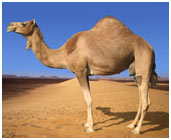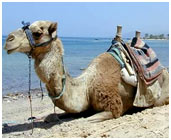Camels are known as the ‘Ship of the Desert’. Given below are some interesting facts and information about Camels.
Facts About Camels
A camel is a large and strong desert animal. Popularly, known as ‘Ship of the Desert’, camels can travel great distances across the vast expanse of the hot and dry sandy areas, with practically no food and water for days. There are two species of camels namely, Dromedary, with one hump and the Bactrian with two humps. The camel is a unique beast. Camels serve people living in such areas in various ways. They carry people and heavy loads as no other means of transportation can exist in deserts. It is said, that the humps are used to store fat for long and cold journeys, which is why these fascinating creatures can go on for days without slowing down for days. They can be milked which is usually consumed fresh for the production of yoghurt or cheese. Apart from this, camel’s wool is used for making rugs and clothes. To know more about this fascinating sturdy animal, read the interesting and amazing facts given below.

Fast Facts
Kingdom: Animalia
Phylum: Chordata
Class: Mammalia
Order: Artiodactyla
Family: Camelidae
Subphylum: Vertebrata
Genus: Camelus
Species: Camelus Bactrianous and Camelus Dromedarius
Height (males): 6 to 7 feet
Weight (males): 500 - 600 kg
Weight (females): 400 to 500 kg
Natural Habitat: Throughout the World
Diet: Herbivorous (Thorny Plants, dry grasses, saltbush)
Age: 50 years
Age of Maturity (females): 3 years
Age of Maturity (males): 6 years
Gestation Period: 406 days (around 13 - 14 months)
Number of Offspring: 8
Interesting & Amazing Information About Camels
- A female camel is called a cow, a male camel is called a bull and a baby camel is called a calf.
- The word ‘camel’ comes from the Arabic word, meaning ‘beauty’.
- A common misconception is that the humps of camels are used to carry water. However, this is not true. The humps store fat, lessening heat-trapping insulation around the rest of the body.
- As early as 1800 BC, camels have been used as the most common means of transport in Africa, Asia and the areas in the Arabian Peninsula. This majestic creature, would often help merchants carry gold, ivory, silk, incense and spices to different parts of the world and the trading capital of ‘Petra’ in Jordan.
- Camels are commonly used by Bedouins, even today.
- Did you know, that the longest fence in the world, which was completed in 1907, in Western Australia, would not have completed without the use of camels.?
- The Bactrian camels are shorter and are able to endure varying temperatures than the Dromedaries. The Bactrian camels are also known for their longer and finer wool.
- It is said that camel’s milk is an acquired taste.
- Camels do not chew the food and swallow it instead. They regurgitate and chew the cud later.
- Camels have thick bushy eyebrows to protect their eyes from the rays of the son.
- Camels shed their coat each year.
- Camels have two layers of thick eyelashes to protect them from the dust.
- Camels have paddy hoofs, with two toes to protect them from sinking in the sand.
- Baby camels are born without a hump
- Camels have three chambers in their stomach.
- Camels can eat thorny twigs without hurting its mouth.
- Camels can live without water for days and even months.
- A camel can drink about 200 liters of water in a day.
- The body temperature of the camel rises during the day and cools off during the night.
- Camels can close their nostrils or leave a small opening to prevent sand from entering inside.
- The tag, ‘The Ship of the Desert’, comes from the camel’s walk. The camel moves both its legs on one side of the body at the same time, which resembles the rolling motion of a ship at sea.
- Camel’s ears are very small and hairy but their hearing power is very strong .


See also
More in 'Society'
More from iloveindia.com
- Home Remedies | Ayurveda | Vastu | Yoga | Feng Shui | Tattoos | Fitness | Garden | Nutrition | Parenting | Bikes | Cars | Baby Care | Indian Weddings | Festivals | Party ideas | Horoscope 2015 | Pets | Finance | Figures of Speech | Hotels in India : Delhi | Hyderabad | Chennai | Mumbai | Kolkata | Bangalore | Ahmedabad | Jaipur
- Contact Us Careers Disclaimer Privacy Policy Advertise With Us Lifestyle Sitemap Copyright iloveindia.com. All Rights Reserved.





